Podcast
Questions and Answers
Which type of bacteria is commonly associated with peritonitis?
Which type of bacteria is commonly associated with peritonitis?
- Clostridium difficile
- Escherichia coli (correct)
- Mycobacterium tuberculosis
- Staphylococcus aureus
What are the types of peritonitis mentioned in the text?
What are the types of peritonitis mentioned in the text?
- Acute, Chronic, Paralytic
- Localized, Systemic, Focal
- Primary, Secondary, Tertiary (correct)
- Chemical, Bacterial, Viral
What factors favor the localization of peritonitis?
What factors favor the localization of peritonitis?
- Age and virulence of the organism
- Geographical location and climate
- Pathological factors and omentum (correct)
- Diet and exercise habits
How does peritonitis spread according to the text?
How does peritonitis spread according to the text?
Which sign is not associated with peritonitis?
Which sign is not associated with peritonitis?
What is the most common symptom of peritonitis?
What is the most common symptom of peritonitis?
What method is often used to diagnose peritonitis?
What method is often used to diagnose peritonitis?
Which type of peritonitis involves injuries to the common bile duct (CBD)?
Which type of peritonitis involves injuries to the common bile duct (CBD)?
What is a common complication of peritonitis?
What is a common complication of peritonitis?
What is a common source of primary streptococcal peritonitis in girls aged 3–6 years?
What is a common source of primary streptococcal peritonitis in girls aged 3–6 years?
What is the most common clinical feature of chronic tuberculous peritonitis?
What is the most common clinical feature of chronic tuberculous peritonitis?
Which presentation is similar to pneumococcal peritonitis?
Which presentation is similar to pneumococcal peritonitis?
What often happens to the omentum in chronic tuberculous peritonitis?
What often happens to the omentum in chronic tuberculous peritonitis?
Which investigation is often used to detect fluid collections in the abdomen during peritonitis?
Which investigation is often used to detect fluid collections in the abdomen during peritonitis?
"Laparoscopy" is used for the diagnosis of which type of peritonitis?
"Laparoscopy" is used for the diagnosis of which type of peritonitis?
What is the largest cavity in the human body?
What is the largest cavity in the human body?
Flashcards are hidden until you start studying
Study Notes
Bacteria Associated with Peritonitis
- Streptococcus pneumoniae is commonly associated with peritonitis.
Types of Peritonitis
- Primary peritonitis
- Secondary peritonitis
- Chronic tuberculous peritonitis
Factors Favoring Localization of Peritonitis
- Presence of adhesions
- Fibrinous exudate
- Omental wrapping
Spread of Peritonitis
- Through the bloodstream (hematogenous spread)
- Direct spread from an infected organ
- Contiguous spread from an infected adjacent organ
Signs Not Associated with Peritonitis
- Flank tenderness
Symptoms of Peritonitis
- Abdominal pain is the most common symptom
Diagnosis of Peritonitis
- Paracentesis (abdominal tap) is often used to diagnose peritonitis
Type of Peritonitis Involving Injuries to the Common Bile Duct (CBD)
- Postoperative peritonitis
Complications of Peritonitis
- Sepsis is a common complication of peritonitis
Source of Primary Streptococcal Peritonitis in Girls
- Gynecological infections are a common source of primary streptococcal peritonitis in girls aged 3-6 years
Clinical Feature of Chronic Tuberculous Peritonitis
- Abdominal distension is the most common clinical feature of chronic tuberculous peritonitis
Presentation Similar to Pneumococcal Peritonitis
- Meningococcal peritonitis presentation is similar to pneumococcal peritonitis
Omentum in Chronic Tuberculous Peritonitis
- The omentum often becomes thickened and inflamed in chronic tuberculous peritonitis
Investigation to Detect Fluid Collections
- Ultrasonography is often used to detect fluid collections in the abdomen during peritonitis
Diagnosis of Peritonitis Using Laparoscopy
- Laparoscopy is often used for the diagnosis of secondary peritonitis
Largest Cavity in the Human Body
- The peritoneal cavity is the largest cavity in the human body
Studying That Suits You
Use AI to generate personalized quizzes and flashcards to suit your learning preferences.




